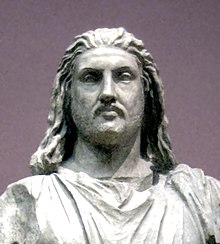| Mausolus | |
|---|---|
 Mausolus, 377–353 BCE. Casting from the Pushkin museum. | |
| Satrap of Caria | |
| In office | 377–353 BCE |
| Predecessor | Hecatomnus |
| Successor | Artemisia II |
| Born | Caria (modern-day Turkey) |
| Died | 353 BCE Halicarnassus, Caria, Achaemenid Empire (modern-day Bodrum, Muğla, Turkey) |
| Burial | |
| Consort | Artemisia II |
| House | Hecatomnids |
| Father | Hecatomnus |
Mausolus (Ancient Greek: Μαύσωλος or Μαύσσωλλος, Carian: [𐊪𐊠]𐊲𐊸𐊫𐊦 Mauśoλ) was a ruler of Caria (377–353 BCE) and a satrap of the Achaemenid Empire. He enjoyed the status of king or dynast by virtue of the powerful position created by his father Hecatomnus (Carian: 𐊴𐊭𐊪𐊳𐊫 K̂tmño), who was the first satrap of Caria from the hereditary Hecatomnid dynasty. Alongside Caria, Mausolus also ruled Lycia and parts of Ionia and the Dodecanese islands. He is best known for his monumental tomb and one of the Seven Wonders of the Ancient World, the Mausoleum at Halicarnassus, the construction of which has traditionally been ascribed to his wife and sister Artemisia.